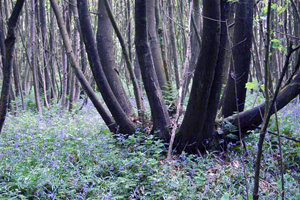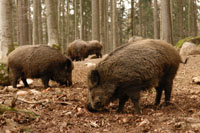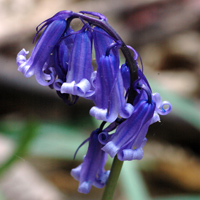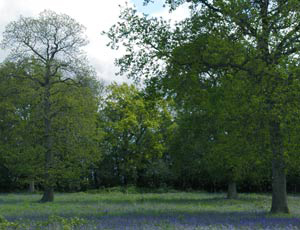Bluebells and boars

Wild boar became extinct in the U.K. in the thirteenth century –so we have been ‘boar free’ for circa 700 years. However, towards the end of the last century commercial pig farming developed; seemingly some escaped and have established free living and breeding populations.
Attitudes to these pigs / boars fall into two broad categories :
- those who welcome the return / reintroduction of a missing species and its ecological impact
- those who have a more negative perception of the boar – in that, they do damage, have the potential to harbour disease and can cause direct damage to people.
However, little investigative work has been done on the effects of boar on wildlife in the U.K, and their present distribution is limited.
 Wild boar are omnivorous, that is, they eat a wide variety of things throughout the different seasons. The diet may include invertebrates (beetles, worms etc), amphibians and small mammals though the bulk of the material ingested is fruits, bulbs and tubers. These are found through their rooting activities. It is the disturbance to soil and vegetation caused by rooting around for food, especially in agricultural land next to woodland, that has cause concern. Rooting can cause physical disruption to plant communities, and it has been suggested that bluebells (in particular) could suffer. Little research into this topic has been done, though Sims looked at recovery after rooting activity (2005, PhD thesis, University of Sussex).
Wild boar are omnivorous, that is, they eat a wide variety of things throughout the different seasons. The diet may include invertebrates (beetles, worms etc), amphibians and small mammals though the bulk of the material ingested is fruits, bulbs and tubers. These are found through their rooting activities. It is the disturbance to soil and vegetation caused by rooting around for food, especially in agricultural land next to woodland, that has cause concern. Rooting can cause physical disruption to plant communities, and it has been suggested that bluebells (in particular) could suffer. Little research into this topic has been done, though Sims looked at recovery after rooting activity (2005, PhD thesis, University of Sussex).
DEFRA and the Forestry Commission recently supported a project on the impact of wild boar on biodiversity (both flora and fauna). The study was carried out in woodlands in Kent and East Sussex, where there are ‘established’ free living population(s) of wild boar. The study involved transects, quadrats and pitfall traps to assess the impact / effect of the wild boar on both plant and animal populations / communities.
The results indicate that if boar populations and rooting activities remain at current levels then, in the short term, bluebells are not unduly threatened though there might be a reduction in the amount of flowering.
The effect, if any, of their activities on trees may not be apparent for some years but it is possible that
- Damage to roots might allow for the entry of pathogens
- Water and mineral uptake could be affected
- The quantity of oak and beech mast (which provide valuable food for boar) if eaten regularly and consistently may be depleted affecting the regeneration / establishment of these tree species
- The rooting could create a good seed bed for the germination and growth of various woodland species.
The work of Harmer, Straw and Williams who undertook this most recent investigation into boar activity is to be found in the Quarterly Journal of Forestry – entitled Boar, bluebells and beetles. It is also available as a downloadable pdf file.
Links to boars and biodiversity
http://www.wildlifeextra.com/go/news/britain-boar011.html#cr
http://cryptozoologynews.blogspot.com/2011/09/wild-boar-not-bad-for-biodiversity-in.html
Comments are closed for this post.
Discussion
Allowing the wild boar to roam in their natural habitat once again is fantastic to hear about. I just hope no one jumps to any conclusions about their impact rather than letting the results determine their fate. Great news.


Some results !!!
https://www.gloucestershirelive.co.uk/news/gloucester-news/boar-won-volunteers-give-up-680980
https://www.gloucestershirelive.co.uk/news/gloucester-news/work-starts-plan-stop-wild-1500929https://www.dailymail.co.uk/news/article-6560219/Man-hits-18-stone-wild-boar-car-Forest-Dean-Gloucestershire-causing-5000-damage.html
Bernie
20 January, 2019